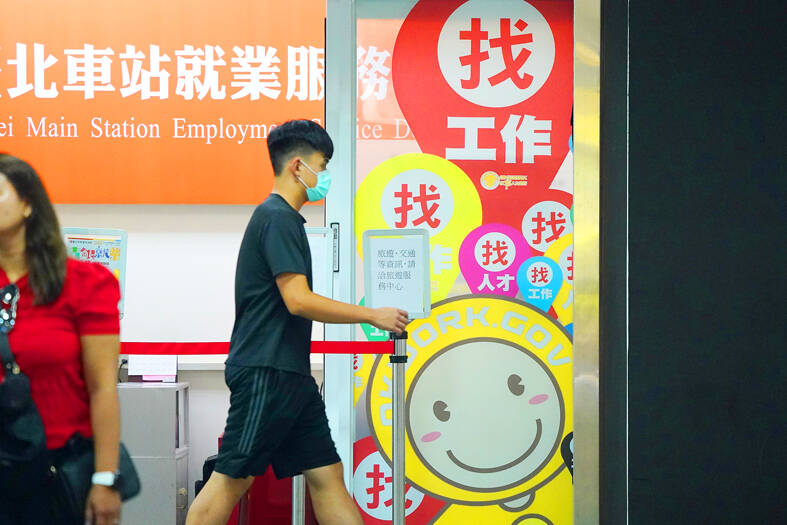The national unemployment rate last month rose 0.03 percentage points to 3.49 percent, as an increase in first-time jobseekers more than offset a drop in people who lost their jobs due to downsizing and closures, the Directorate-General of Budget, Accounting and Statistics (DGBAS) said yesterday.
The reading is the lowest for June in 23 years, despite the arrival of graduation season, thanks to healthy labor demand in the service sector, the statistics agency said.
“Although the labor market was resilient, exporters are taking a hit from soft demand and put more than 10,000 people on unpaid leave,” Census Department Deputy Director Chen Hui-hsin (陳惠欣) said.

Photo: CNA
After seasonal adjustments, the jobless rate fell 0.05 percentage points to 3.45 percent, affirming a stable market, Chen said.
The number of unemployed people was 417,000 last month, up 1.03 percent from May, as the number of first-time jobseekers grew by 5,000, the DGBAS’ monthly survey showed.
Meanwhile, the number of people who were laid off due to business downsizing and closures fell by 1,000.
Chen said there was no need to worry about a seasonal rise in unemployment rates, which tend to increase 0.11 to 0.24 percentage points between May and August.
The unemployment rate rose only slightly last month due to the Dragon Boat Festival holiday starting on June 22, which boosted business at retailers, restaurants, hotels and recreational facilities, she said.
Service providers added 10,000 people to their payrolls, while the agricultural sector hired 1,000 workers, she said, adding that manufacturers, by contrast, fired 1,000 people.
The number of people who worked less than 35 hours due to economic reasons was 202,000, 19,000 fewer than a month earlier and within the range of the 180,000 to 220,000 prior to the COVID-19 pandemic, she said.
By education level, people with university degrees had the highest unemployment rate at 4.8 percent, followed by those with high-school diplomas at 3.22 percent, people with graduate degrees at 2.81 percent and people with junior-high or lower education at 2.39 percent, the DGBAS said.
People aged 20 to 24 had the highest unemployment rate of 12.03 percent, followed by those aged 15 to 19 at 8.42 percent, 25 to 29 at 5.97 percent and 30 to 34 at 3.72 percent, it said.
People 45 or older had the lowest jobless rate of 2.13 percent.
The average unemployment period was 20.9 weeks, 1.7 weeks shorter than in May, while it was 18.7 weeks for first-time jobseekers, it said.
Taiwan’s unemployment rate is higher than Hong Kong’s 3 percent, South Korea’s 2.7 percent and Japan’s 2.7 percent, DGBAS data showed.

Taiwan Semiconductor Manufacturing Co (TSMC, 台積電) yesterday said that its investment plan in Arizona is going according to schedule, following a local media report claiming that the company is planning to break ground on its third wafer fab in the US in June. In a statement, TSMC said it does not comment on market speculation, but that its investments in Arizona are proceeding well. TSMC is investing more than US$65 billion in Arizona to build three advanced wafer fabs. The first one has started production using the 4-nanometer (nm) process, while the second one would start mass production using the

When an apartment comes up for rent in Germany’s big cities, hundreds of prospective tenants often queue down the street to view it, but the acute shortage of affordable housing is getting scant attention ahead of today’s snap general election. “Housing is one of the main problems for people, but nobody talks about it, nobody takes it seriously,” said Andreas Ibel, president of Build Europe, an association representing housing developers. Migration and the sluggish economy top the list of voters’ concerns, but analysts say housing policy fails to break through as returns on investment take time to register, making the

‘SILVER LINING’: Although the news caused TSMC to fall on the local market, an analyst said that as tariffs are not set to go into effect until April, there is still time for negotiations US President Donald Trump on Tuesday said that he would likely impose tariffs on semiconductor, automobile and pharmaceutical imports of about 25 percent, with an announcement coming as soon as April 2 in a move that would represent a dramatic widening of the US leader’s trade war. “I probably will tell you that on April 2, but it’ll be in the neighborhood of 25 percent,” Trump told reporters at his Mar-a-Lago club when asked about his plan for auto tariffs. Asked about similar levies on pharmaceutical drugs and semiconductors, the president said that “it’ll be 25 percent and higher, and it’ll

CHIP BOOM: Revenue for the semiconductor industry is set to reach US$1 trillion by 2032, opening up opportunities for the chip pacakging and testing company, it said ASE Technology Holding Co (日月光投控), the world’s largest provider of outsourced semiconductor assembly and test (OSAT) services, yesterday launched a new advanced manufacturing facility in Penang, Malaysia, aiming to meet growing demand for emerging technologies such as generative artificial intelligence (AI) applications. The US$300 million facility is a critical step in expanding ASE’s global footprint, offering an alternative for customers from the US, Europe, Japan, South Korea and China to assemble and test chips outside of Taiwan amid efforts to diversify supply chains. The plant, the company’s fifth in Malaysia, is part of a strategic expansion plan that would more than triple